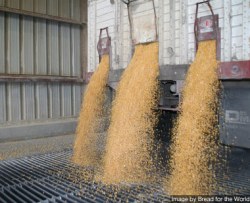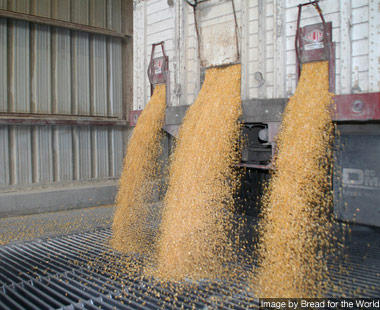 Can U.S. farmers keep filling the nation’s bellies as they scramble to fuel its cars?
Can U.S. farmers keep filling the nation’s bellies as they scramble to fuel its cars?
Given its evident gravity, the question has drawn remarkably little debate. Like it or not, though, more and more food is being devoted to fueling the nation’s 211-million-strong auto fleet. High gasoline prices, a dizzying variety of government supports, and an investment frenzy have caused corn-based ethanol production to more than triple since 1998.
As recently as a year ago, corn seemed wildly overproduced. Suddenly, it’s a hot commodity. In 1998, about 5 percent of the corn harvest (526 million bushels) went into ethanol production, according to the National Corn Growers Association. This year, the U.S. Department of Agriculture expects ethanol producers to use upward of 2 billion bushels, or nearly 20 percent of the crop.
And ethanol’s voracious appetite for corn isn’t expected to abate anytime soon. According to the pro-ethanol Renewable Fuels Association, 109 ethanol refineries currently churn out 5.3 billion gallons of ethanol a year — and an additional 56 plants (plus expansions at seven existing ones) have broken ground. When these new plants are on line, the industry’s capacity will nearly double, to 9.7 billion gallons a year.
Presumably, its demand for corn will nearly double, too — and that means higher food prices for consumers.
Corn Hits a 10-Year High
For most of the past five years, steadily rising ethanol demand has had little effect on corn prices. Bolstered by generous subsidies, corn farmers churned out more than enough product to satisfy demand from ethanol plants while holding prices steady.
This year, though, after the gasoline industry abruptly abandoned MTBE and embraced ethanol as an oxygenate enhancer, ethanol demand spiked, and the price of corn finally followed suit. A bushel of corn currently fetches about $3.45 — a 10-year high that leaves last year’s low of $1.50 in the dust.
Considering that corn suffuses the U.S. food system — it’s the main feed for beef, poultry, egg, dairy, and hog production, and provides sweetness for candy, cereal, soft drinks, and other supermarket staples — its price can’t suddenly jump without causing repercussions. In the early 1970s, a sudden spike in grain prices quickly upped the cost of meat, making it a luxury even for many middle-class families. (Hamburger Helper, anyone?)
Tyson Foods, the world’s largest meat and poultry processor, has already signaled that a similar scenario might be on the way now. “I believe the American consumer is going to have to pay more for protein,” Tyson CEO Richard L. Bond recently told investors. “Quite frankly, the American consumer is making a choice here … either corn for feed or corn for fuel.”
Elsewhere, The Wall Street Journal recently explained succinctly why poultry prices will soon reflect corn’s new popularity as a fuel source. Because of higher corn prices, “It costs nearly a nickel more to produce a pound of chicken today than at the end of 2005, yet the 20-year average industry profit margin per pound of chicken is two cents. This means poultry producers either will have to raise prices or slash other costs.”
It should be noted that any farmer who has survived the last 20 years in the poultry business has already slashed costs to the bone; higher prices seem inevitable. And adding a nickel a pound for whole chickens at the farm level will ripple up the food system, translating to higher increases on the supermarket shelf.
The Boom Heard ‘Round the World
While the industrial-food system is easy to criticize, it’s important to recognize that vast numbers of people rely on it for cheap sustenance. For more than 30 years, real growth in average wages has, at best, floundered. According to University of Massachusetts economist Robert Pollin’s Contours of Descent: The Economic Consequences of Clinton, Bush, and Greenspan, real hourly wages peaked at $15.73 in 1973 and by 2000 stood at $14.15 (in 2001 dollars). And that was after a rare three-year growth spurt provoked by the stock-market bubble; since 2000, wages have essentially flatlined.

Take this cob and shove it.
Photo: iStockphoto
Not surprisingly, tens of millions face what the USDA calls “food insecurity,” which the agency defines as the condition of households being “uncertain of having, or unable to acquire, enough food to meet the needs of all their members because they had insufficient money or other resources for food.”
In that context, the federally funded effort to divert billions of bushels of corn into ethanol with scant public debate seems cavalier.
Moreover, the pattern of booming biofuel production driving up feedstock prices is also taking root in developing countries — where, the U.N. Food and Agriculture Organization claims [PDF], some 800 million people face persistent hunger and malnutrition.
In a blunt report last week, The Wall Street Journal vividly illustrated the effect of booming European demand for biodiesel on Southeast Asian palm-oil production. Prices for the tropical fat have jumped more than 30 percent in 2006, spurring rapid deforestation as landowners scramble to plant more palm, the Journal reports.
Meanwhile, Brazil’s successful sugarcane ethanol program has inspired copycats — and a rally in sugar prices. Sugar prices recently came off 25-year highs, but that’s only because growers in other areas are scrambling to plant cane and thus increase supply. According to the Journal, “In India, environmental activists say, water tables are dropping as farmers try to boost production of ethanol-yielding sugar.”
Deforestation, falling water tables — these are hardly the hallmarks of a fuel source that can reasonably be called “renewable,” much less an agriculture strategy designed to maintain food-production capacity. And rising prices for food commodities, without other social reforms, will only translate to more misery for the global south.
Already, the FAO is sounding the alarm. The agency claims that world grain prices are at ten-year highs in part because of “fast-growing demand for biofuel production.” These high prices, the FAO warns, cause “dismay [for] many developing countries that rely on the international market to meet their staple food needs,” many of which will “reduce food purchases, not always in response to their own improved domestic supplies but rather because of the high international prices.”
Covering Every Inch
Here in the United States, cellulosic ethanol, which could theoretically utilize non-food crops such as switchgrass, is often held up as the panacea for a truly green biofuel that needn’t have much effect on food prices.
Yet the process for extracting sugars from cellulose remains, 30 years since the government first started investing in research for it, just beyond the grasp of viable commercial-scale production. USDA chief economist Keith Collins recently told Congress not to expect significant fuel contributions from cellulose for “some years into the future.”
In that testimony, Collins articulated the official response to reining in food prices as ethanol production booms: grow more corn. That’s a bracing strategy in a nation that already produces 42 percent of the world’s supply of the crop.
Because of the ethanol boom, “The United States will need substantial increases in corn acreage to prevent exports from declining and livestock profitability from falling,” Collins declared. He reckoned that by 2010, the 80 million acres currently devoted to corn would need to expand by an additional 10 million acres to meet rising demand for ethanol. Where to find them? Collins points to the Conservation Reserve Program, the 36 million acres of marginal, environmentally sensitive land the government now pays farmers to keep fallow.
Moreover, per-acre corn yields — driven by copious dousings of fossil-fuel-derived fertilizers, genetically modified seeds, pesticides, and investments in heavy farm machinery — must rise, from about 148 bushels per acre in 2005 to 155 bushels by 2010, Collins claimed.
Even with these measures, Collins predicts, corn prices will likely “set new record highs over the next five or six years.” And he acknowledges that the strategy will offset little fossil-fuel use. “Corn ethanol alone,” he told Congress, “cannot greatly reduce U.S. dependence on crude oil.”
Mano a Monocrop
Given the environmentally ruinous nature of corn production, the economist Collins presents an odd plan for clean energy.

The never-ending harvest.
Photo: iStockphoto
Indeed, squeezing yet more corn from the land to make a relatively small amount of auto fuel might not even deliver a net reduction in greenhouse gases. Michael B. McElroy, professor of environmental studies at Harvard, recently wrote that “the reduction in net emissions of carbon dioxide obtained by using corn rather than petroleum as a ‘feedstock’ for motor fuel is largely offset by additional emissions of the several hundredfold more potent greenhouse gas, nitrous oxide, formed as a byproduct of the nitrogen fertilizer used to grow the corn.”
Such a corn-centric strategy might even impede our ability to grow food. Blanketing even greater swaths of the Midwest with ever-intensely cultivated, monocropped, chemically reliant corn plants seems like a recipe for further degrading the nation’s richest store of topsoil.
Yet current public policy is pushing us decisively in that direction. In his exhaustive study of the complex array of biofuel subsidies, Doug Koplow estimated [PDF] that total government support for ethanol will soon reach between $6.3 billion and $8.7 billion. (In fiscal year 2005, by contrast, Amtrak received $1.2 billion in federal funding.)
Despite the gargantuan annual outflow of government cash, public discussion of the ethanol question has been muted. In the last election, the political debate centered on which of the two major parties embraced ethanol more.
That must change. Hinging so much of the U.S. food system on monocropped corn agriculture was always a dubious decision. Extending corn’s domain to the nation’s gas tanks compounds the error, and can hardly be counted on to provide a sustainable supply of food or fuel.
With food prices rising and environmentally sensitive land in the U.S. and the global south alike going under the plow to plant fuel crops, it’s time for a blunt international debate on the wisdom of biofuel.

